February 2009
Monthly Archive
February 19, 2009
(This is one of my articles in the Fall 08-Winter 09 issue of Animail, published by the Montgomery County Humane Society)
Sweet NC puppy mill survivors receive TLC at MCHS Rescue
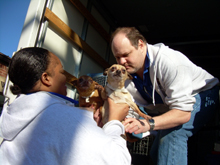 Just in time for Valentine’s Day, the Montgomery County Humane Society saved 15 dogs rescued a week earlier from a puppy mill in Wayne County, NC. Mostly small breeds – Yorkies, Poodles, Chihuahuas, Pomeranians and Shih-Tzus – many were emaciated, severely matted, had overgrown their collars, and were suffering from dental and other serious medical ailments.
Just in time for Valentine’s Day, the Montgomery County Humane Society saved 15 dogs rescued a week earlier from a puppy mill in Wayne County, NC. Mostly small breeds – Yorkies, Poodles, Chihuahuas, Pomeranians and Shih-Tzus – many were emaciated, severely matted, had overgrown their collars, and were suffering from dental and other serious medical ailments.
The scene on the day of their arrival showed MCHS teamwork in action. Staff and volunteers lined up at the MCHS Private Rescue to welcome the dogs and start them on the path to recovery and love. Some had severely matted coats, all were filthy, and all had overgrown nails.
“It is appalling that any breeder would allow animals to be raised this way,” said MCHS President and CEO Cris Bombaugh. “These dogs are now getting the medical attention, grooming and TLC they so badly need with our staff and volunteers.”
Truly the lucky ones
A year-long investigation by The Humane Society of the United States into Thornton’s Kennels led to the seizure of these dogs. The HSUS and Wayne County Animal Control partnered to rescue almost 300 neglected animals. Volunteers with United Animal Nations oversaw a temporary emergency shelter in North Carolina.
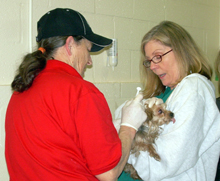 As the dogs were handed from person to person coming off the truck in Rockville, each one was given a core vaccine and examined for ear mites and eye infections. All allowed themselves to be held close by gentle human arms.
As the dogs were handed from person to person coming off the truck in Rockville, each one was given a core vaccine and examined for ear mites and eye infections. All allowed themselves to be held close by gentle human arms.
“Despite not having been handled with care and compassion by humans, these dogs were incredibly tolerant and trusting as we clipped nails, removed mats from those with longer hair, gave them baths and dried them, and cleaned their ears,” said Aileen Montgomery, MCHS board co-chair. “I can assure you that they had not ever been clean before, yet they cooperated with bathing and everything else.”
Just before press time, Robert Henne, manager of the MCHS Private Rescue, said, “The dogs are doing great with social and physical rehabilitation.” They were starting to play bow and chew on toys soon after settling in. By the week following their arrival, they were made available for adoption visits and applications.
“The compassion of the volunteers and community has been amazing,” he added. “It would have been impossible for us to save these animals without them.”
From misery to comfort
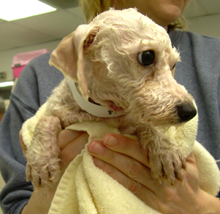 Montgomery said their progress spoke to the unconditional love and trust these animals have for people, even though they had been mistreated for all of their lives until now. “They enjoy and eagerly respond to human attention, but don’t quite know what it’s all about or how to ask for it. Some climbed into my lap today and fell asleep when I held them. I wonder if they’ve ever been warm, clean and able to sleep peacefully without all of the noise, stench, squalor, and discomfort they endured in the puppy mill, which was an unvented warehouse and outhouses, housing these dogs in very small wire cages.”
Montgomery said their progress spoke to the unconditional love and trust these animals have for people, even though they had been mistreated for all of their lives until now. “They enjoy and eagerly respond to human attention, but don’t quite know what it’s all about or how to ask for it. Some climbed into my lap today and fell asleep when I held them. I wonder if they’ve ever been warm, clean and able to sleep peacefully without all of the noise, stench, squalor, and discomfort they endured in the puppy mill, which was an unvented warehouse and outhouses, housing these dogs in very small wire cages.”
O’Malley, one of the smallest dogs, will make somebody a wonderful companion, Montgomery added.. “She has come a very long way already and even came to me (OK, for some canned food). She did climb into my lap and I held her for quite some time. She slept like a rock – I didn’t have the heart to move and awaken her. You have to wonder if any of these dogs ever slept peacefully in that putrid, noisy dump.”
“I think they are finally able to relax,” Laureen Prebilic, manager of the MCHS Foster Program, summed up. “The dogs that went to a foster
home have just been lying on the foster parents’ laps and sleeping. I
don’t think they could relax like that in that hell hole. It’s so great
we were able to get them out of that puppy mill and into a much better
life.
“I love what I do.”
—
Permission to reprint provided credit is given to the Montgomery County Humane Society /
b j Altschul
—
Speak out against puppy mills
MCHS Board Co-chair Aileen Montgomery said there are tens of thousands of other puppy mills that we don’t know about yet. “That’s what makes all of us nuts. Please heighten awareness however you can that puppies purchased from pet stores support these inhumane operations.”
HSUS is currently strongly urging local law enforcement to pursue criminal charges against the North Carolina mill owner and bar her from breeding dogs in the future. Legislation has been introduced in Maryland and a number of other states to limit the number of dogs in puppy mills and to require humane treatment. Please contact your legislators and ask them to help prevent cruelty to animals raised in these facilities.
—
Facts About Puppy Mills
Source: The Humane Society of the United States
See the campaign at StopPuppyMills.org
- Approximately one-third of the nation’s independent pet stores sell puppies.
- The HSUS estimates that 2 to 4 million puppy mill puppies are sold each year in the U.S.
- Puppy mill puppies often have health problems, genetic defects and behavioral issues.
- Documented puppy mill conditions include over-breeding, inbreeding, minimal veterinary care, poor food and shelter, crowded cages and lack of socialization.
- Dogs kept for breeding in puppy mills suffer for years in continual confinement. They are bred as often as possible and then destroyed or discarded once they can no longer produce puppies.
- Pet stores and puppy mills use attractive websites to hide the truth and to dupe the public into thinking that they are dealing with a reputable breeder.
- Reputable breeders never sell puppies over the Internet or through a pet store and will insist on meeting the family who will be purchasing the dog.
- Puppy mills contribute to the pet overpopulation problem which results in millions of unwanted dogs euthanized at shelters every year.
—
Key media coverage to date
Potential new owners vie for rescued dogs from alleged puppy mill
by Melissa Brachfeld on Gazette.net, 2/20/09
Puppy Rescue
Michael Jamal (sp?), WUSA 9 News Now, 2/19/09
Humane Society takes in 15 rescued dogs
by Melissa Brachfeld in The Gazette, 2/18/09
Rescued puppies need homes
by Aaron Stern in the Potomac Almanac, 2/18/09
NC puppy mill survivors ready for adoption in Mont. County. Photos!
by Michelle Critchell in DC Dogs Examiner, 2/18/09
County Humane Society takes in 15 rescued dogs
by Melissa Brachfeld on Gazette.net, 2/13/09
Puppy mill bust brings battered dogs to Rockville
Online story by Ashley E. Brown for NBCWashington.com, 2/12/09
with video reported by Miguel Almaguer for NBC 4
The NBC video has been picked up by network affiliates along the East Coast, MSNBC, and at least one national blog I’m aware of:
Puppy mill dogs headed to a better life
For the Love of the Dog, 2/12/09
Selected other mentions:
Rescued puppies brought to DC
Fox 5 TV, 2/12/09 (see end of 3rd graf and tail end of video)
Dogs rescued in N.C. destined for D.C. adoptions
News Channel 8, 2/12/09 (link to MCHS website, and mention at tail end of video clip)
###
Our rating: Puppy mills — 0 kongs
Rescuers — 1,000 kongs
February 9, 2009
This terrific post by Christie Keith on PetConnection.com previews the new 3-year campaign the Ad Council is undertaking on behalf of The Humane Society of the US and Maddie’s Fund. Both Marley and Me (partnering with the American Humane Association) and Hotel for Dogs (partnering with Pedigree dog food) are also promoting pet adoptions (see posts elsewhere on this blog). With this big a push in national media, more shelter animals literally may see daylight than without these campaigns.
Launch is anticipated mid-year, with creative developed by DraftFCB in Chicago.
February 9, 2009
So many dog-mags, so little time to read them all!
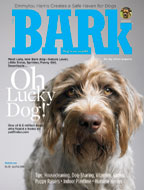 In my “spare” time that is what I do — read dog magazines. #1 on my list for “culture” (since 1997; I have an almost complete collection!) has always been The Bark (taglines “Dog is my co-pilot” and “the New Yorker for dog lovers”; lots of content available free online). More recently, there’s a slew of new and not-so-new pubs on the market: American Dog (target market predecessors: Colorado Dog and Chicago Dog), Baltimore Dog (not related to American Dog or its affiliates), and NovaDog (not that much local content to start out other than the calendar; focus is almost 100% on Northern Virginia and the District, little or nothing on suburban Maryland). Older dog lifestyle pubs include Modern Dog (since 2003), and Fido Friendly (also since 2003; for travels with your pooch). These are all supported by advertising and take a hip, upscale approach to “life with dog.”
In my “spare” time that is what I do — read dog magazines. #1 on my list for “culture” (since 1997; I have an almost complete collection!) has always been The Bark (taglines “Dog is my co-pilot” and “the New Yorker for dog lovers”; lots of content available free online). More recently, there’s a slew of new and not-so-new pubs on the market: American Dog (target market predecessors: Colorado Dog and Chicago Dog), Baltimore Dog (not related to American Dog or its affiliates), and NovaDog (not that much local content to start out other than the calendar; focus is almost 100% on Northern Virginia and the District, little or nothing on suburban Maryland). Older dog lifestyle pubs include Modern Dog (since 2003), and Fido Friendly (also since 2003; for travels with your pooch). These are all supported by advertising and take a hip, upscale approach to “life with dog.”
For health and behavior, my #1 choice is the Whole Dog Journal (selected content available free online; other online content for paid subscribers only). Other faves for health are two newsletters from vet schools — DogWatch from Cornell, and Your Dog from Tufts (index and selected articles archived online). While there’s often some repetition as assorted stories take prominence depending on research announcements and breaking news, I like getting the reinforcement of content from multiple sources. All three of these are independent to one degree or another, i.e., not supported by advertising. The two vet school publishers naturally highlight their own vets; the good news is that the writing is consumer-friendly and informative rather than forcing you to take their word as gospel. WDJ is completely independent, giving their writers 100% free range to be critical thinkers. All three are more than favorably disposed toward positive training, especially WDJ.
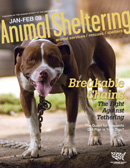 If you’re in the (companion) animal welfare world, there’s Animal Sheltering Magazine (lots of content available free online), published by The Humane Society of the US. If you’re in that world, you already understand that shelters and rescue organizations around the country are not connected to HSUS in any kind of parent-organization-and-chapters structure. HSUS does provide support and guidance, and AS often does so through thoughtful, in-depth feature discussions. You may not always agree with their conclusions; regardless, the discussion is plentiful to prompt your own thinking even more. If you’re not already a staffer or volunteer with an animal organization, AS will give you some keen insights into the joys and challenges of this type of work.
If you’re in the (companion) animal welfare world, there’s Animal Sheltering Magazine (lots of content available free online), published by The Humane Society of the US. If you’re in that world, you already understand that shelters and rescue organizations around the country are not connected to HSUS in any kind of parent-organization-and-chapters structure. HSUS does provide support and guidance, and AS often does so through thoughtful, in-depth feature discussions. You may not always agree with their conclusions; regardless, the discussion is plentiful to prompt your own thinking even more. If you’re not already a staffer or volunteer with an animal organization, AS will give you some keen insights into the joys and challenges of this type of work.
I would love to hear from editors, publishers and readers around the country about other magazines and significant newsletters in your geographic areas. Is anyone holding local animal care organizations (think shelters, rescues, animal control, nonprofits, etc.) up for scrutiny? I’m not talking about coverage in your local media such as newspapers, TV and online. I’m talking about hard copy magazines whose content focus is dogs. I want to know who’s being looked at under the magnifying glass, why, and how the outcome of such investigation is evolving. Not just the fun lifestyle stuff, but things like shelter management, how the animals are being treated (or not), community success (or failure) in finding a good balance between animal and human populations. In other words, who cares enough to identify local problems and report on them regularly through specialty publications? Is there a market for that kind of content anywhere?
February 3, 2009
 Since Feb. 7-14 is “Have a Heart for Chained Dogs Week,” this is a great time to plug one of my favorite titles in the United Animal Nations HEAR program (Humane Education Ambassador Readers). Buddy Unchained tells the story of an all-American pup who was chained, neglected, left to the elements, and generally miserable… until he was rescued, brought to a shelter, and then adopted by a loving family. Told in simple language from Buddy’s point of view, with beautifully drawn and detailed color illustrations, the story helps children understand why chaining a pet is a terrible way to treat an animal. When a trained reader (facilitator) leads kids in discussion — asking both “what” and “why” questions — the youngsters learn to empathize with Buddy and build critical thinking skills. Animal welfare educators are aiming for kids to realize early in their young lives that they can recognize cruelty to animals and do something about it. Buddy’s story is one that gives them tools for action.
Since Feb. 7-14 is “Have a Heart for Chained Dogs Week,” this is a great time to plug one of my favorite titles in the United Animal Nations HEAR program (Humane Education Ambassador Readers). Buddy Unchained tells the story of an all-American pup who was chained, neglected, left to the elements, and generally miserable… until he was rescued, brought to a shelter, and then adopted by a loving family. Told in simple language from Buddy’s point of view, with beautifully drawn and detailed color illustrations, the story helps children understand why chaining a pet is a terrible way to treat an animal. When a trained reader (facilitator) leads kids in discussion — asking both “what” and “why” questions — the youngsters learn to empathize with Buddy and build critical thinking skills. Animal welfare educators are aiming for kids to realize early in their young lives that they can recognize cruelty to animals and do something about it. Buddy’s story is one that gives them tools for action.
Our rating: 10 kongs
February 3, 2009
 I finally got to see Hotel for Dogs. After helping to staff a table for the Montgomery County Humane Society at three area theaters when the film first opened, at last it was my turn to actually see the picture. And it was a lot of fun!
I finally got to see Hotel for Dogs. After helping to staff a table for the Montgomery County Humane Society at three area theaters when the film first opened, at last it was my turn to actually see the picture. And it was a lot of fun!
As with Marley, there are a few flaws in the concept, but overall it’s a family-friendly “tail” of entertainment that ends on a clever note. In this case, the flaw is the way the local “pound” is depicted — run by men who are uncaring, and focusing simply on getting unwanted dogs off the streets and out of people’s way as fast as possible, rather than on compassion and giving strays a chance at being matched with a new, loving family. There’s a reference as the plot builds to a “no kill” shelter just across the county line, but no explanation that not all pounds are shelters, and vice versa, let alone that there’s even such a thing as an open admission shelter that can be no kill. But I understand that omission — that’s a discussion that is truthfully beyond the scope of this kid pic and one I hope to take up later in this blog.
So the discerning viewer should consider these two aspects: Entertainment value (high for its target audience), and bottom line — whether the human characters do right by the canines (ultimately, yes). What’s not to love about a cast of dozens of multicultural dogs who’ve been so perfectly trained to behave as a team? They not only sit, bark, and high five on cue, they also take care of bidness together. The Hotel ultimately gets converted into a high end adoption center, boarding facility, and retail pet supply shop all in one, and even the kids (Emma Roberts, Jake Austin) get a happy ending when their social worker (Don Cheadle) and his wife adopt them.
There’s also an abundance of product placement advertising for Pedigree dog food, which made me wonder a couple of times if I was watching a feature-length commercial that happened to have a story wrapped around it. Nevertheless, Pedigree is to be commended for its campaign to promote pet adoptions from shelters — a theme reflected in the commercials developed for Super Bowl.
In a nuanced way, Hotel offers up a critique not only of those animal facilities that are inhumane, but also of the foster child system in the U.S. If we can learn that animals’ lives are not to throw away, then surely we can act on the underlying theme that children’s lives also are to to throw away. We still have a lot to learn about the human-animal bond, how to foster and protect it.
Our rating: 8.7 kongs
 Just in time for Valentine’s Day, the Montgomery County Humane Society saved 15 dogs rescued a week earlier from a puppy mill in Wayne County, NC. Mostly small breeds – Yorkies, Poodles, Chihuahuas, Pomeranians and Shih-Tzus – many were emaciated, severely matted, had overgrown their collars, and were suffering from dental and other serious medical ailments.
Just in time for Valentine’s Day, the Montgomery County Humane Society saved 15 dogs rescued a week earlier from a puppy mill in Wayne County, NC. Mostly small breeds – Yorkies, Poodles, Chihuahuas, Pomeranians and Shih-Tzus – many were emaciated, severely matted, had overgrown their collars, and were suffering from dental and other serious medical ailments. As the dogs were handed from person to person coming off the truck in Rockville, each one was given a core vaccine and examined for ear mites and eye infections. All allowed themselves to be held close by gentle human arms.
As the dogs were handed from person to person coming off the truck in Rockville, each one was given a core vaccine and examined for ear mites and eye infections. All allowed themselves to be held close by gentle human arms. Montgomery said their progress spoke to the unconditional love and trust these animals have for people, even though they had been mistreated for all of their lives until now. “They enjoy and eagerly respond to human attention, but don’t quite know what it’s all about or how to ask for it. Some climbed into my lap today and fell asleep when I held them. I wonder if they’ve ever been warm, clean and able to sleep peacefully without all of the noise, stench, squalor, and discomfort they endured in the puppy mill, which was an unvented warehouse and outhouses, housing these dogs in very small wire cages.”
Montgomery said their progress spoke to the unconditional love and trust these animals have for people, even though they had been mistreated for all of their lives until now. “They enjoy and eagerly respond to human attention, but don’t quite know what it’s all about or how to ask for it. Some climbed into my lap today and fell asleep when I held them. I wonder if they’ve ever been warm, clean and able to sleep peacefully without all of the noise, stench, squalor, and discomfort they endured in the puppy mill, which was an unvented warehouse and outhouses, housing these dogs in very small wire cages.” In my “spare” time that is what I do — read dog magazines. #1 on my list for “culture” (since 1997; I have an almost complete collection!) has always been
In my “spare” time that is what I do — read dog magazines. #1 on my list for “culture” (since 1997; I have an almost complete collection!) has always been  If you’re in the (companion) animal welfare world, there’s
If you’re in the (companion) animal welfare world, there’s  Since Feb. 7-14 is “
Since Feb. 7-14 is “ I finally got to see
I finally got to see 



